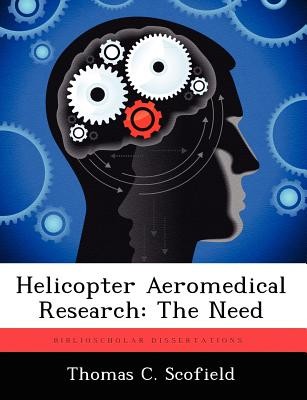
- We will send in 10–14 business days.
- Author: Thomas C Scofield
- Publisher: BiblioScholar
- ISBN-10: 1249366917
- ISBN-13: 9781249366911
- Format: 18.9 x 24.6 x 0.6 cm, softcover
- Language: English
- SAVE -10% with code: EXTRA
Reviews
Description
The need for helicopter aeromedical research is examined from several aspects: (1) a historical review of aeromedical research from the beginning of flight to the establishment of an Army helicopter aeromedical research laboratory in 1962; (2) the correlation of physiological problems associated with each new development in airplane technology; (3) an analysis of the Army, Navy, and Air Force aeromedical research facilities, capabilities, and programs; (4) a comparative analysis of the three military department's aircraft resources; and (5) a review of the threat facing Army ground forces today. The study reveals an imperative need for a dedicated helicopter aeromedical research capability and indicates that present facilities and funds are inadequate. An analysis of the three military department's research facilities, capabilities, and programs indicate a duplication of research facilities within the Air Force and between the Air Force and Navy in the areas of impact acceleration and high sustained acceleration. There is no duplication in facilities in the Army or between the Army and the other military departments. A review of the threat faced by United States ground forces in Europe reinforces the need for a dedicated helicopter aeromedical research facility to support the Army's expanded use of helicopters in a high intensity conflict. As new and more efficient helicopters are developed, a new generation of physiological problems are created and must be solved if men are to operate helicopters safely and effectively. Among these problems are severe visual restraints, crash survivability, life support equipment needs, combined stresses, new demands on night vision, and sustained performance of aircrews. The need for helicopter aeromedical research continues longitudinally and increases significantly with the development of more complex and sophisticated helicopters.
EXTRA 10 % discount with code: EXTRA
The promotion ends in 16d.16:14:45
The discount code is valid when purchasing from 10 €. Discounts do not stack.
- Author: Thomas C Scofield
- Publisher: BiblioScholar
- ISBN-10: 1249366917
- ISBN-13: 9781249366911
- Format: 18.9 x 24.6 x 0.6 cm, softcover
- Language: English English
The need for helicopter aeromedical research is examined from several aspects: (1) a historical review of aeromedical research from the beginning of flight to the establishment of an Army helicopter aeromedical research laboratory in 1962; (2) the correlation of physiological problems associated with each new development in airplane technology; (3) an analysis of the Army, Navy, and Air Force aeromedical research facilities, capabilities, and programs; (4) a comparative analysis of the three military department's aircraft resources; and (5) a review of the threat facing Army ground forces today. The study reveals an imperative need for a dedicated helicopter aeromedical research capability and indicates that present facilities and funds are inadequate. An analysis of the three military department's research facilities, capabilities, and programs indicate a duplication of research facilities within the Air Force and between the Air Force and Navy in the areas of impact acceleration and high sustained acceleration. There is no duplication in facilities in the Army or between the Army and the other military departments. A review of the threat faced by United States ground forces in Europe reinforces the need for a dedicated helicopter aeromedical research facility to support the Army's expanded use of helicopters in a high intensity conflict. As new and more efficient helicopters are developed, a new generation of physiological problems are created and must be solved if men are to operate helicopters safely and effectively. Among these problems are severe visual restraints, crash survivability, life support equipment needs, combined stresses, new demands on night vision, and sustained performance of aircrews. The need for helicopter aeromedical research continues longitudinally and increases significantly with the development of more complex and sophisticated helicopters.


Reviews